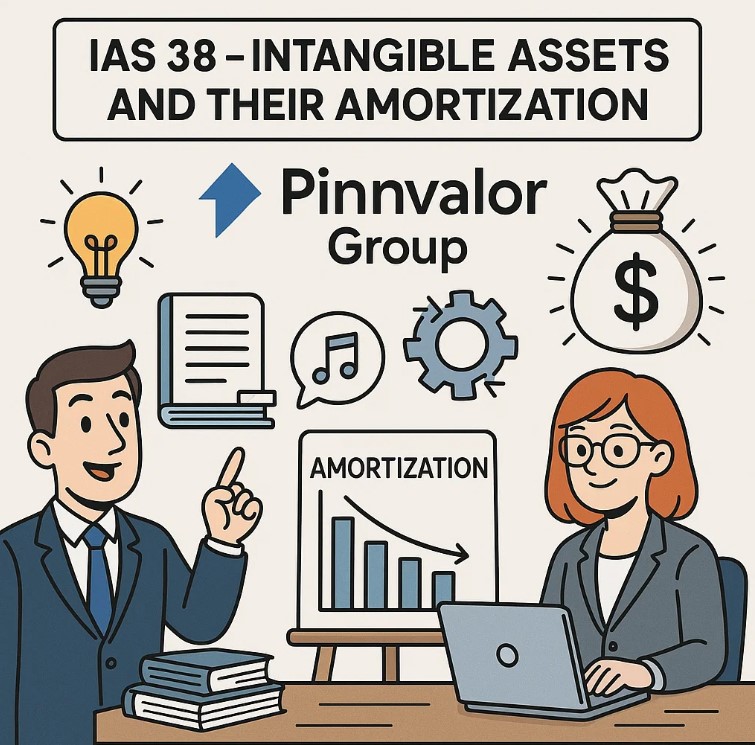
IAS 38 – Intangible Assets and their Amortization
Intangible assets—think patents, trademarks, copyrights, software—represent some of the most critical yet elusive values on a company's balance sheet. IAS 38 of IFRS provides the guiding framework for recognizing, measuring, and amortizing such assets. As the modern economy shifts toward knowledge and technology, understanding IAS 38 is more important than ever.
Are you fully leveraging IAS 38 to unlock the true value of your company’s intangible assets?
Amortization under IAS 38 ensures intangible assets are systematically expensed over their useful life, balancing accuracy and insight in financial reporting.
📌 What is IAS 38?
IAS 38 – Intangible Assets governs the accounting treatment of identifiable non-monetary assets without physical substance. It outlines the criteria for recognition, methods of measurement, and guidance on amortization and impairment.
🧠 Key Characteristics of Intangible Assets
- Identifiability: Either separable or arises from contractual/legal rights.
- Non-monetary: Does not represent a right to receive cash or cash equivalents.
- No physical substance: Unlike PPE, it cannot be touched or held physically.
📝 Recognition Criteria under IAS 38
An intangible asset is recognized only if:
- It is probable that future economic benefits will flow to the entity, and
- The cost of the asset can be measured reliably.
This excludes most internally generated goodwill, brands, and customer lists.
🔍 Internally Generated Intangible Assets
IAS 38 distinguishes between the research and development phases:
- Research Phase: Costs must be expensed.
- Development Phase: Costs can be capitalized if strict criteria are met.
These criteria include technical feasibility, intent to complete, future economic benefits, and ability to reliably measure expenditure.
💰 Initial Measurement
All intangible assets are initially measured at cost. This includes purchase price, import duties, and directly attributable costs.
📈 Subsequent Measurement
Entities can choose between:
- Cost Model: Carry at cost less accumulated amortization and impairment losses.
- Revaluation Model: Only if there’s an active market, asset can be carried at fair value less subsequent amortization and impairment.

⏳ Amortization of Intangible Assets
- Finite Life: Amortize over the useful life. The amortization method should reflect the pattern in which the asset’s benefits are consumed.
- Indefinite Life: Not amortized but must be tested for impairment annually.
Common amortization methods: Straight-line, declining balance, or unit-of-production method.
📉 Impairment Testing
Regardless of useful life, intangible assets must be tested for impairment under IAS 36 if indicators of impairment exist—or annually for assets with indefinite useful life or not yet available for use.
🧾 Derecognition of Intangible Assets
An intangible asset is derecognized:
- On disposal (e.g., sale or scrapping), or
- When no future economic benefits are expected from its use or disposal.
Any resulting gain or loss is included in profit or loss.
📊 Real-World Examples
- Software Development: Costs incurred during the development phase of proprietary software may be capitalized.
- Franchise Rights: Recognized as intangible assets and amortized over the contract period.
- Customer Lists: Acquired in a business combination and separately identifiable – hence capitalized.
🚫 What IAS 38 Does Not Cover
- Financial assets (IAS 32 & IFRS 9)
- Exploration and evaluation assets (IFRS 6)
- Goodwill (covered under IFRS 3)
🔍 Key Judgements & Challenges
Some grey areas and practical challenges include:
- Estimating useful life and residual value
- Determining amortization method
- Assessing whether an intangible has an indefinite life
- Distinguishing research from development
📌 Summary Table: At a Glance
| Aspect | IAS 38 Guidance |
|---|---|
| Recognition | Probable future benefits + reliable measurement |
| Initial Measurement | Cost |
| Subsequent Measurement | Cost or Revaluation Model |
| Amortization | Only for finite life assets |
| Impairment | IAS 36 applicable |
| Derecognition | On disposal or no future benefit |
💡 Final Thoughts
IAS 38 reflects the evolving role of intellectual capital in today’s business landscape. From tech firms to pharmaceutical giants, the standard ensures intangible assets are recognized and amortized systematically and reliably. For finance professionals, mastery of IAS 38 is not just technical—it’s strategic.
